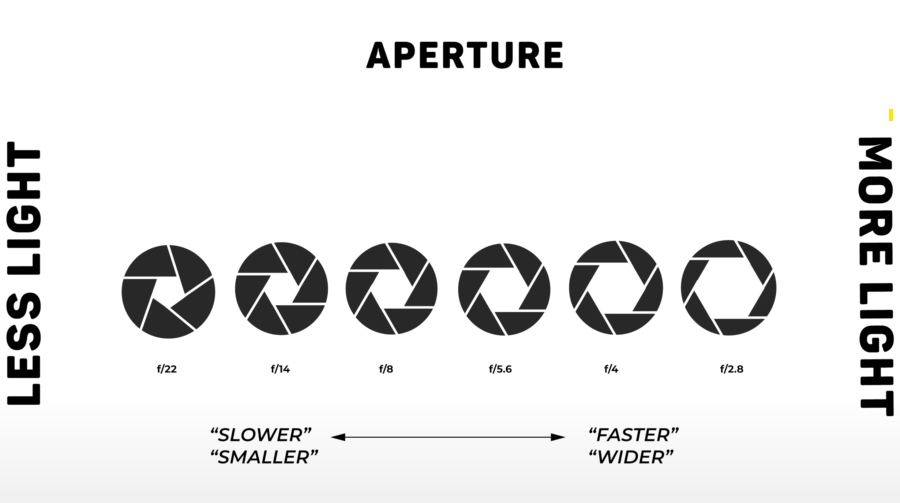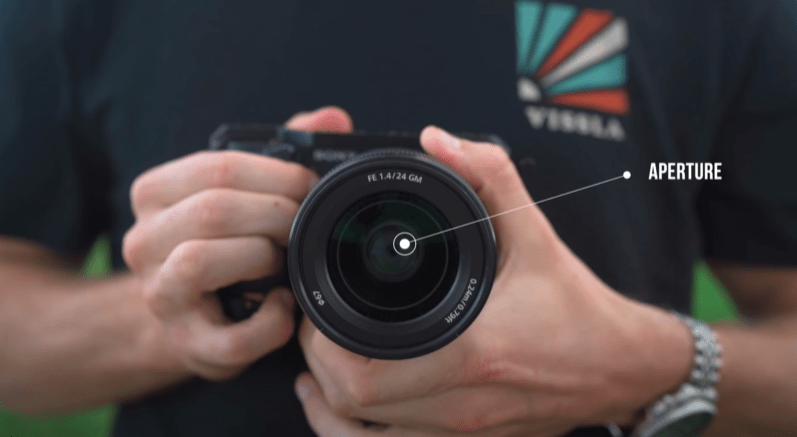Aperture is one of the most important settings on your camera. This article will cover what it is, how to use it, and standard aperture settings.
The aperture is an essential element of photography, allowing photographers to adjust the amount of light reaching their camera’s sensor.
By using an aperture, photographers can also control depth-of-field (the range of focus) and create stunning photographs with precise focus.

This article will cover the basics of aperture – what it is, how to use it, and standard aperture settings.
We’ll also discuss how to choose the right aperture for your photography needs.
Basics of Aperture: What is the Aperture in A camera?
The aperture is the size of the opening in a camera lens. It determines how much light passes through to the sensor.

The wider the aperture (the lower the f-stop number), the more light will pass through, creating a brighter image.
On the other hand, narrowing down the aperture (higher f-stop numbers) will decrease the amount of light entering, making for a darker image.
Aperture also directly affects depth of field; having a wider one will give your images a more shallow depth of field (background blur) while using a smaller one gives you a greater depth of field (more focus across your photo).
Understanding Large and Small Apertures
A large aperture (e.g., f/1.4) will let in more light than a small aperture (e.g., f/22).
This means you can take photos in lower light conditions with a large aperture without needing to use flash or dramatically increase your ISO setting.
Related: What is ISO?
Also, having more light available results in less noise and better overall image quality.

The downside of using a large aperture is that it gives you a very shallow depth of field.
This means that the subject will be in focus, but elements in the background and foreground will be blurred out. If you are looking for an image with lots of detail from front to back (e.g., landscape shots), then a smaller aperture (f/8 or higher) is more appropriate.
Another advantage of small apertures is that they have a greater depth of field, meaning that both the subject and objects in the background and foreground remain in focus. This makes them ideal for nature photography, where capturing as much detail as possible is essential.
What About F-Stop and F-Number?
F-stop is the amount of light entering a camera lens that corresponds to an f-number. F-numbers are written as fractions, such as f/1.4 or f/2.8.
The lower the number, the more light is allowed into the camera sensor, creating a shallow field depth with blurry backgrounds.
The higher the number, the less light is let in, producing sharper images with more depth of field. You can adjust F-stops on most cameras by turning a dial or pushing buttons to change aperture settings.
Understanding what each setting does is essential to get the right exposure and desired effect for your photos.
How To Use Aperture?
Once you understand the principles of aperture, it’s time to put those theories into practice. Here are some tips to help you get started:
- Choose your camera settings wisely: Use a low f-number for wide-angle shots and a high number for zoomed-in shots. Aperture is typically adjusted manually on most cameras, so ensure that the appropriate settings are selected.
- Take advantage of different lighting conditions: If you’re shooting outdoors, use natural light by adjusting your aperture. If it’s too bright, use a higher f-stop to reduce the light entering your lens; if it’s too dark, use a lower f-stop to let in more light.
- Play around with depth of field: Experiment with shallow and deep depth of field by adjusting the aperture accordingly. If you want the background to blur out, use a wider aperture; if you want everything in focus, use a smaller one.
- Adjust your shutter speed: When using a wide aperture, adjust your shutter speed accordingly so that your images don’t come out overexposed or too dark.
- Remember about ISO settings: Adjust your ISO settings in low-light conditions. A higher ISO allows more light to be captured and can lead to noise and grainy images.
Common Aperture Settings?
When it comes to aperture settings, the most common ones used tend to be f/8 and f/11. These are good all-purpose settings that will cover a wide range of situations. They provide a good depth of field and sufficient light reach for most situations.
However, depending on your subject matter or the lighting conditions, you might need to adjust the aperture setting accordingly. For example, if you’re shooting a landscape in bright sunlight, you may want to use a smaller aperture like f/16 or f/22 to create more depth of field. On the other hand, if you’re shooting in low light conditions where there is not much available light, you might need to open up your aperture by selecting a larger f-stop like f/2.8 or f/4 to allow more light into the camera.
FAQs: What Do Most People Ask About Camera’s Aperture?
How does the aperture affect my image?
Aperture affects your image in several ways: it controls the amount of light entering your camera, allowing you to adjust exposure settings; it also impacts the sharpness and blurriness of an image due to its effects on depth of field, and it influences the overall look and feel of an image by changing the way light behaves.
What is a good aperture range?
Generally speaking, a wide aperture (f/2.8 to f/5.6) is best for creating shallow depth of field and isolating your subject from the background, while a smaller aperture (f/11 to f/22) is better for landscapes and other shots where you want everything in focus. Your exact aperture setting will depend on your specific needs and photo style.
What is the “sweet spot” of a lens?
The sweet spot of a lens is the aperture at which it produces its sharpest images. This is usually a few stops down from the maximum aperture and will vary from lens to lens. To find your lens’ sweet spot, you should do some tests with different aperture settings and review the results. You can also refer to online reviews or ask other photographers for their opinion.
How does shutter speed work with the aperture?
Shutter speed and aperture create an exposure as they determine how much light reaches the camera sensor. A slower shutter speed requires more light, so if you want to keep your shutter speed constant, you must adjust your aperture accordingly. Conversely, if you keep your aperture stable, you will have to adjust your shutter speed accordingly. It is essential to keep both settings balanced to expose the image correctly.
Can I use a manual aperture mode?
Yes, many cameras have an aperture priority mode which allows you to manually control the aperture setting while allowing the camera to choose the shutter speed it needs for proper exposure automatically. This can be useful when shooting in low light or to create a specific look with depth of field. However, it is essential to remember that overexposing or underexposing an image can lead to poor results, so always check your settings and ensure you are using the correct exposure.
What is the depth of field?
Depth of field refers to the amount of an image in sharp focus, from front to back. A wide aperture (smaller f/number) will create a shallow depth of field, while a small aperture (larger f/number) will create a greater depth of field. The exact effect depends on several factors, such as focal length, distance to the subject, and camera sensor size. It is best to experiment with different aperture settings to find the look that works for your particular shot.
Can I control my image’s depth of field?
You can also adjust the distance between your camera and the subject. The closer you are to a subject, the more shallow the depth of field will be; conversely, the further away you are from a subject, the greater the depth of field will be. Additionally, using a longer focal length lens (such as a telephoto lens) will create a shallower depth of field compared to a shorter focal length lens (such as a wide-angle lens). Again it is best to experiment with different settings to get the look you want.
Conclusion
Aperture is one of photography’s three pillars, shutter speed and ISO. It’s widely considered the most important, as it directly affects both image quality and brightness. A higher aperture (smaller f-number) results in a sharper, brighter image, while a lower aperture (larger f-number) leads to a darker, more blurred photo. Mastering the art of aperture will help you take your photos to the next level. If you have any questions or need clarification, leave a comment below, and we’ll be happy to help!